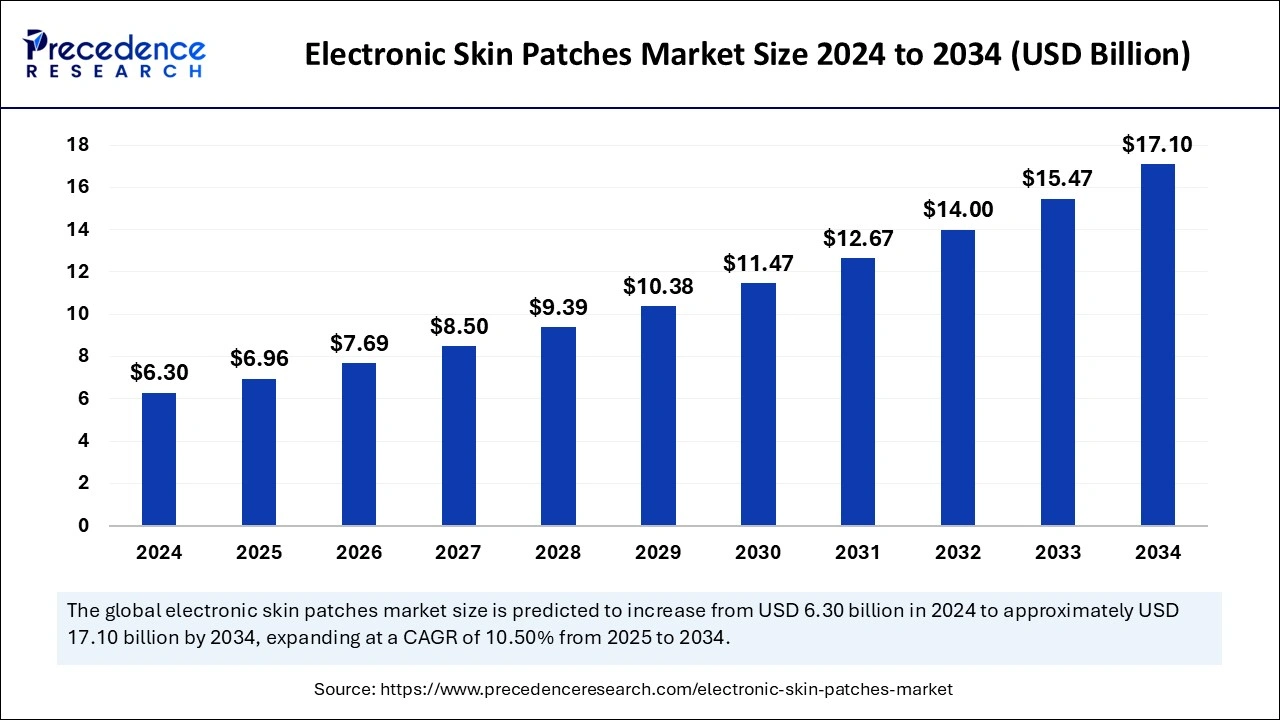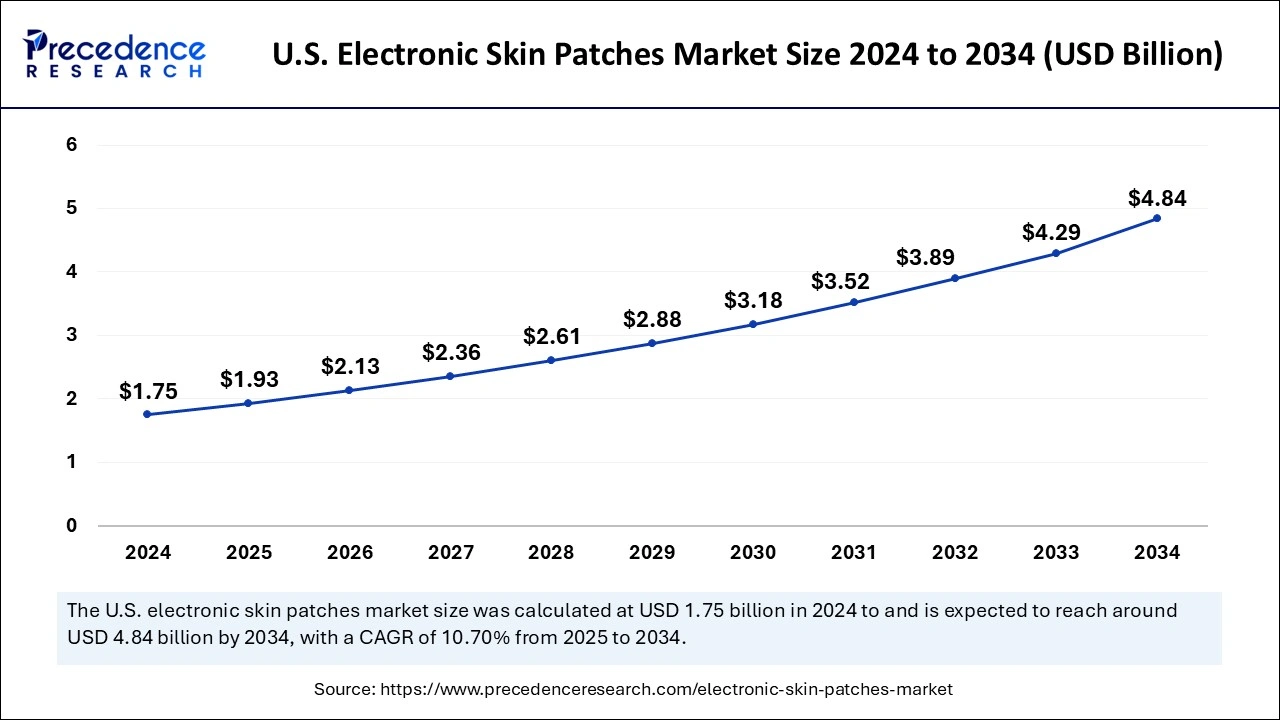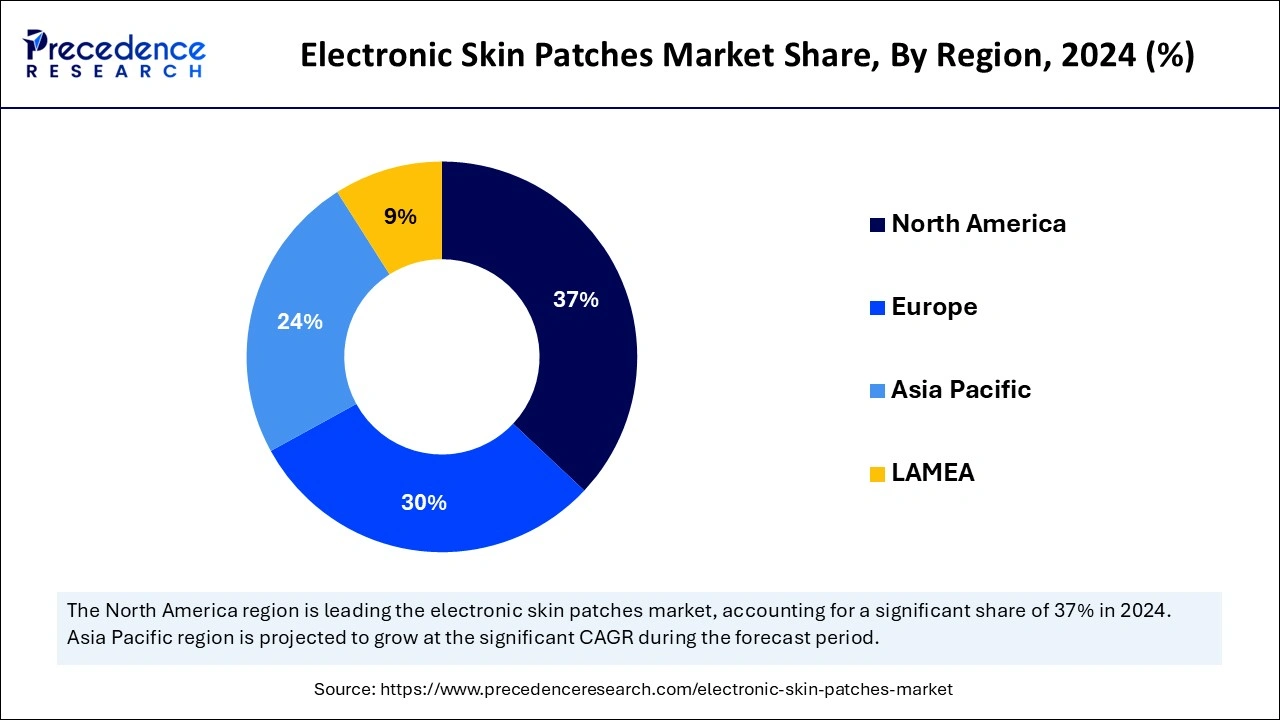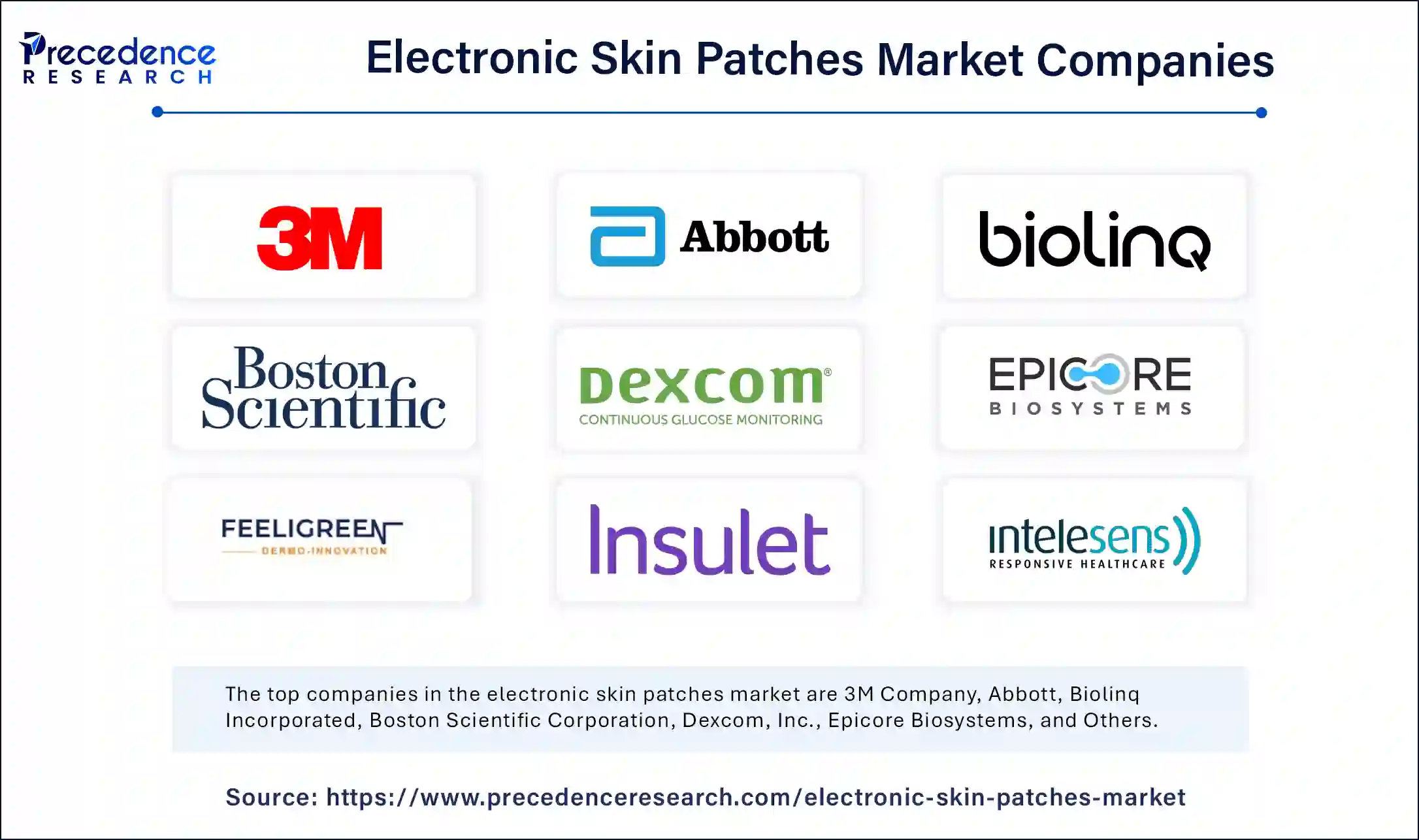September 2024
The global electronic skin patches market size is calculated at USD 6.96 billion in 2025 and is forecasted to reach around USD 17.10 billion by 2034, accelerating at a CAGR of 10.50% from 2025 to 2034. The North America market size surpassed USD 2.33 billion in 2024 and is expanding at a CAGR of 10.64% during the forecast period. The market sizing and forecasts are revenue-based (USD Million/Billion), with 2024 as the base year.
The global electronic skin patches market size was estimated at USD 6.30 billion in 2024 and is predicted to increase from USD 6.96 billion in 2025 to approximately USD 17.10 billion by 2034, expanding at a CAGR of 10.50% from 2025 to 2034. The rising demand for a non-invasive and comfortable approach to monitoring vital signs and other physiological parameters contributes to the growth of the electronic skin patch market.

The integration of artificial intelligence into electronic skin patches has transformed the medical device industry. AI holds the potential to optimize the device's material by bringing innovative discoveries and sensor designs to a new automated e-skin patch. Along with that, it helps analyze health data collected by electronic skin devices. It is expected to show promising outcomes with high-accuracy diagnosis in cardiac complications.
AI can rapidly detect even small and gradual cardiovascular changes. It also predicts mental health issues by offering real-time monitoring of stress hormones. Furthermore, in manipulating robotics and providing human aid, AI-powered electronic skin in a human-machine interface offers rapid analysis and interpretation of multimodal data. It captures complex hand movements and transmits physical information to the computer systems making commands.
The U.S. electronic skin patches market size was exhibited at USD 1.75 billion in 2024 and is projected to be worth around USD 4.84 billion by 2034, growing at a CAGR of 10.70% from 2025 to 2034.

Market Mastery: North America Takes the Helm in the Electronic Skin Patches Market
North America dominates the electronic skin patches market with the largest revenue share. The primary drivers of electronic skin patches in North America are healthcare spending and research and development into designing innovative products. The best medical device companies in America are Medtronic, Johnsons & Johnson’s, Abbott, SIEMENS, and many more, bringing significant innovations that have changed the healthcare industry.
The National Health Expenditure Accountants (NHEA) from the Centers for Medicare & Medicaid Services (CMS) provide data on health spending in the United States. The spending includes the type of service, funding, sponsor, and inflation adjustment. In 2023, the United States spent over $4.9 trillion on health care, which is 7.5% more than in previous years. To date, the United States has spent more than 67.1 billion on medical devices.

Asia Pacific on Rise: Electronic Skin Patches Market to Witness Unpredictable Growth
Asia Pacific is expected to grow at the fastest rate during the forecast period. The expansion of this region is credited to the increasing awareness of chronic disease, government investment in healthcare, and collaboration among industry leaders. Wearable health monitoring devices are greatly adopted in this region as they offer significant potential in the effective management of chronic disease.
Top leaders of continuous glucose monitors (CGMs) are Dexcom, Medtronic, Abbott, Senseonics, and Ascensia in Asia Pacific, which helps in diabetes management by providing real-time glucose reading, which results in precise insulin dosage and improved glycemic control. The Chinese government has increased its investment in healthcare infrastructure by 5.9% of GDP by 2030, according to the Health Research Policy and Systems.
Electronic skin patches are an advancement towards wearable technology in the medical device sector. The design of an electronic skin patch consists of a flexible product that is attached to an individual’s skin with the help of a biocompatible adhesive. It comprises electronic components such as sensors, processors, and communication elements. It is commonly used to count steps, monitor cardiac rhythm and temperature, drugs and cosmetic delivery, smart wound care, and many more things similar to a smartwatch.
Electronic skin patches help in improving health and provide clinical outcomes. In contrast to traditional medical devices, these devices are compact, lightweight, more comfortable, and less intrusive for users. These patches have additional features for single-use, short-term, or extended use.
| Report Coverage | Details |
| Market Size by 2034 | USD 17.10 Billion |
| Market Size in 2025 | USD 6.96 Billion |
| Market Size in 2024 | USD 6.30 Billion |
| Market Growth Rate from 2025 to 2034 | CAGR of 10.50% |
| Dominating Region | North America |
| Fastest Growing Region | Asia Pacific |
| Base Year | 2024 |
| Forecast Period | 2025 to 2034 |
| Segments Covered | Type, Application, Patient, Material, End-Use, and Regions. |
| Regions Covered | North America, Europe, Asia-Pacific, Latin America, and Middle East & Africa |
A broad range of application
The electronic skin patch device is proven to be an excellent device for remote monitoring for both inpatient and outpatient due to its reliable and convenient properties. The attached skin patch helps in the management and monitoring of diabetes, cardiovascular disease, and many more. Other than healthcare monitoring, athletes use it while running marathons to measure the distance, pay close attention to heart rates, and analyze their performance. Electronic skin patches are also used in robotics to sense the touch and interact with environmental objects more delicately, prosthetics to provide sensory feedback to amputees, and even in consumer electronics for personalized health tracking.
Slow growth in material development
Wearable technology is advancing in terms of features, but the material is still behind. Most wearable devices have a rigid and sometimes bulky design, and they cannot be worn directly attached to the body. This creates discomfort and may also provide inaccurate results, especially for heart patients; inaccurate heart rate measurements can give false indications, leading to overexertion and further health issues. In some cases, the material may not be compatible with the skin, which might cause irritation and other health complications. Human skin naturally produces oils and sweat, which hinders the adhesive's sticking properties. It is extremely crucial to test direct-to-skin adhesive, which includes acrylic, rubber-based, and silicone, before wearing the device.
Robotics and prosthetics
The electronic skin patches market is anticipated to expand more significantly towards robotics and prosthetics. Future trends and technologies will bring a revolutionary change in electronic skin technology, from self-healing to material advancement and sensing functions. Bluetooth-connected polymers are expected to be witnessed, and they will offer wireless monitoring of human vital signs, speech, and coughing rates. Electronic skin will evolve in the robotics field by enhancing interaction and communication between robots and humans by enabling robotics to feel temperature, pressure, textures, shape, and many more.
The monitoring & diagnostics segment accounted for a considerable share of the electronic skin patches market in 2024. The e-skin patches commonly used for medical monitoring and diagnosis which includes monitoring heart, diabetes management, fertility, sleep, brain activity, and pregnancy, contribute to the dominance of this segment. They are utilized for different purposes as required such as during sports activities and for control and surveillance of different medical conditions. The innovative fabricated technique used in skin patches provides simultaneous monitoring of various parts of the body parameters while providing temperature-moisture management.
The therapeutic Electronic skin patches segment is anticipated to grow with the highest CAGR during the studied years. The electronic skin patch device can deliver medications and nutrients into to body through minimal invasion. This aids in treating the disease and preventing illness and other medical complications.
The diabetes management segment held a dominant presence in the market in 2024. Diabetes management is achieved by an e-skin patch as it offers continuous glucose monitoring (CGM) and insulin patch pumps. The electronic skin patches sense the excess glucose in sweat and automatically administer drugs by heating up microneedles that penetrate the skin. The sensors are made from enzyme-based glucose which keeps an account of pH and temperature to improve the accuracy of glucose measurement from sweat.
The cardiovascular monitor segment is expected to grow at the fastest rate during the forecast period of 2025 to 2034 due to its thin, stretchable, and flexible property of patches which can be used to monitor cardiovascular health. These skin patches are worn on the skin for continuous monitoring of heart, blood pressure, and other essential vital signs.
The adult patch segment accounted for a considerable share of the market in 2024. the dominance of this segment is credited to the more usability of electric skin patches among adults. Adults use skin patches for prevention, diagnosis, and treatment of illness and injuries, it is commonly used by sports athletes to monitor their performance. Adults use it to monitor glucose level, activating attached components including diabetes medicine dispense, drug and cosmetic delivery, and electrical stimulation devices.
Pediatric patch segment is anticipated to grow with the highest CAGR during the studied years. the electronic skin patches used for pediatrics allows for a proper diagnosis, treatment and management of health condition depending on the age of the particular child. This device helps in early detection of the presence of any critical conditions in childing which leads to timely treatment and enhanced quality of life.
The silicone segment dominated the market in 2024. The electronic skin patches are commonly made from silicone-based material including silicon nanomembranes. Silicones offer unique properties such as flexibility, excellent conductivity, and the ability to be tailored into intricate circuits while maintaining their thin and conformable form. This mimics the characteristics of human skin, making it comfortable to wear.
The polymer segment is observed to be the fastest-growing in the market during the forecast period. recently scientists have proven that polymer electrodes for electric skin patch applications are ideal due to their improved electrical conductivity. Along with that, this is a cheaper and simpler alternative. Still, there are more enhancements needed when it comes to using polymer as a viable alternative. This material is non-toxic which significantly improves performance and has biocompatibility with human skin.
The hospital & clinics segment marked its dominance over the market in 2024. electronic skin patches have become an essential healthcare tool and is expected to expand more in the future. In hospitals and clinics, this is administrated by professionals for better, accurate diagnosis of disease, monitoring of the condition, intensive care, and continuous monitoring of vitals.
The specialty clinics segment is expected to grow at the fastest rate in the market during the forecast period of 2024 to 2034. The usage and performance is the same as it is done in hospitals and clinics. However, specialty clinics have the advantage of offering personalized treatment plans within specific specialties. Additionally, there is an increasing demand for focus and advanced medical care through specialized expertise.

By Type
By Application
By Patient
By Material
By End-Use
By Geography
For inquiries regarding discounts, bulk purchases, or customization requests, please contact us at sales@precedenceresearch.com
No cookie-cutter, only authentic analysis – take the 1st step to become a Precedence Research client
September 2024
January 2025
November 2024
September 2024